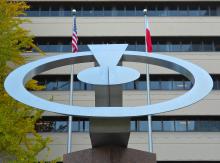Listen to today's episode of StarDate on the web the same day it airs in high-quality streaming audio without any extra ads or announcements. Choose a $8 one-month pass, or listen every day for a year for just $30.
You are here
Radium
In the early 20th century, radium was all the rage. It was used in paints that made the faces of clocks and watches glow in the dark. It was the key element in early medical radiation treatments. It was infused into water and chocolates, and was a big selling point for spas whose waters had a lot of the element. Alas, all of those were bad ideas. Radium is highly radioactive, and most likely was responsible for the deaths of thousands.
Radium came to the world’s attention 125 years ago today. Marie and Pierre Curie announced its discovery to the French Academy of Sciences. The discovery earned the Curies half of the 1903 Nobel Prize in Physics.
Marie Curie discovered the first hint of the element. She was studying pitchblende — a dark ore that contains a lot of uranium. Her experiments showed that the ore was producing far more radioactivity than could be accounted for by uranium alone. She thought it must contain another radioactive element. It took a while, but she and Pierre eventually isolated it. After Pierre died, Marie and another colleague isolated the metal — work that helped her earn a second Nobel, for chemistry.
Radium is produced by the radioactive decay of uranium. Radium itself decays quickly, so there’s none left from Earth’s formation.
Today, radium’s use is limited — mainly to scientific research and instruments — non-lethal applications for a prize-winning element.
Script by Damond Benningfield





